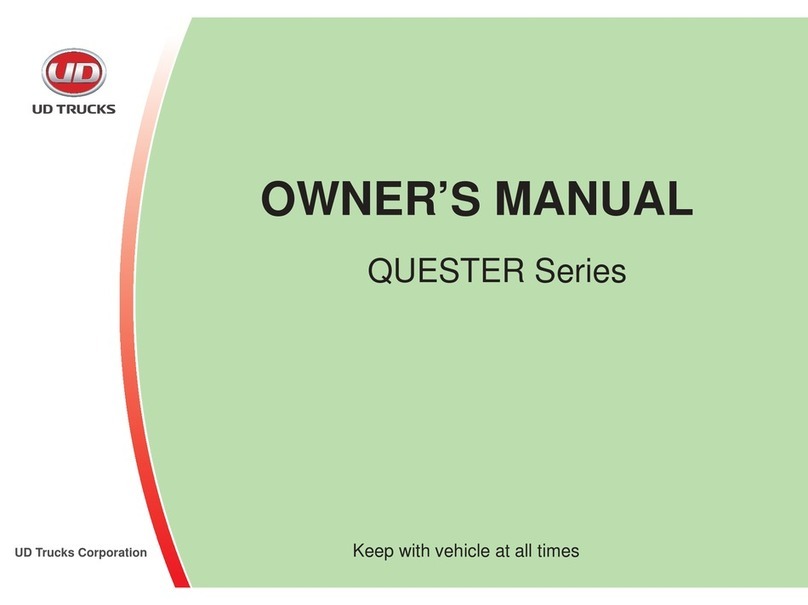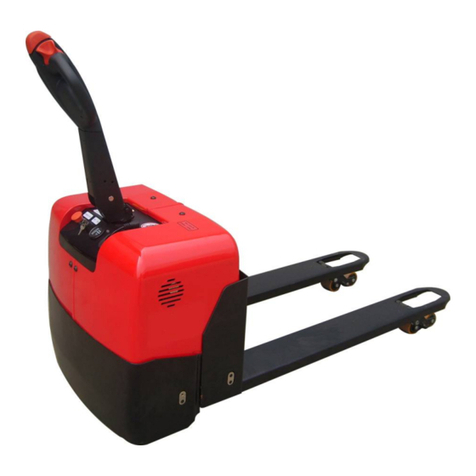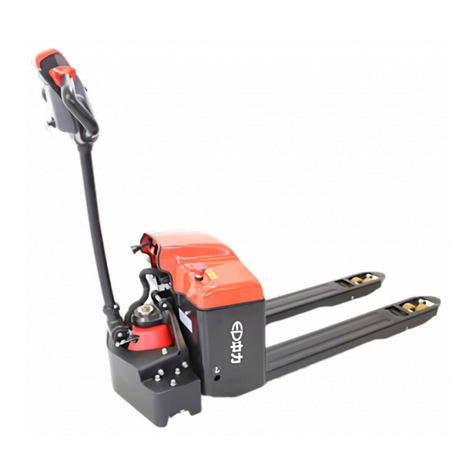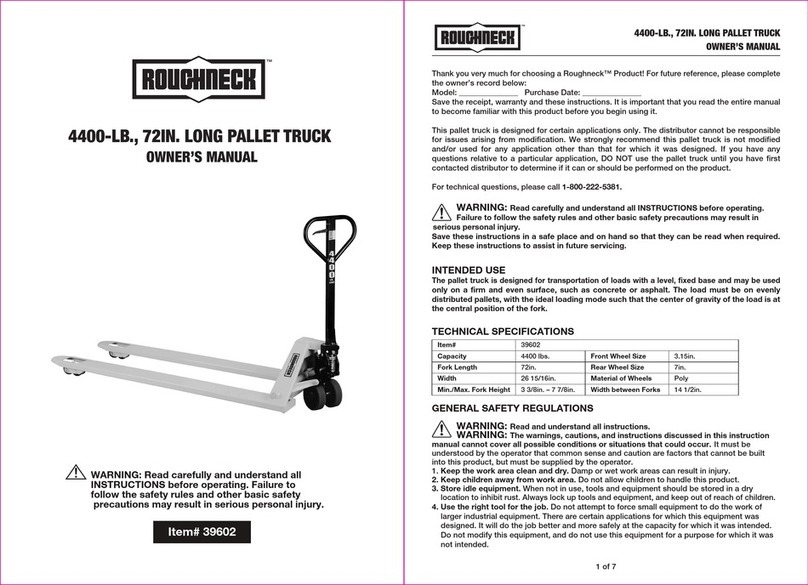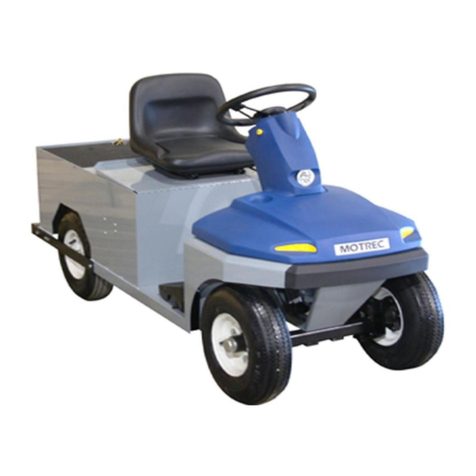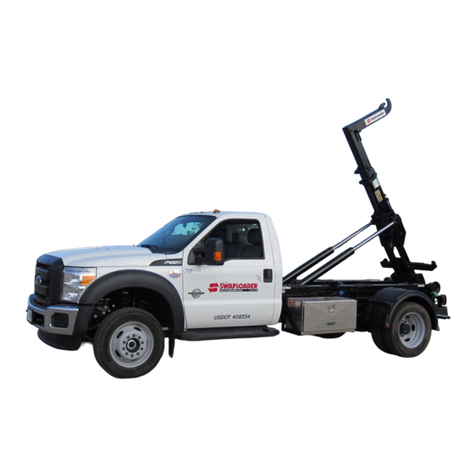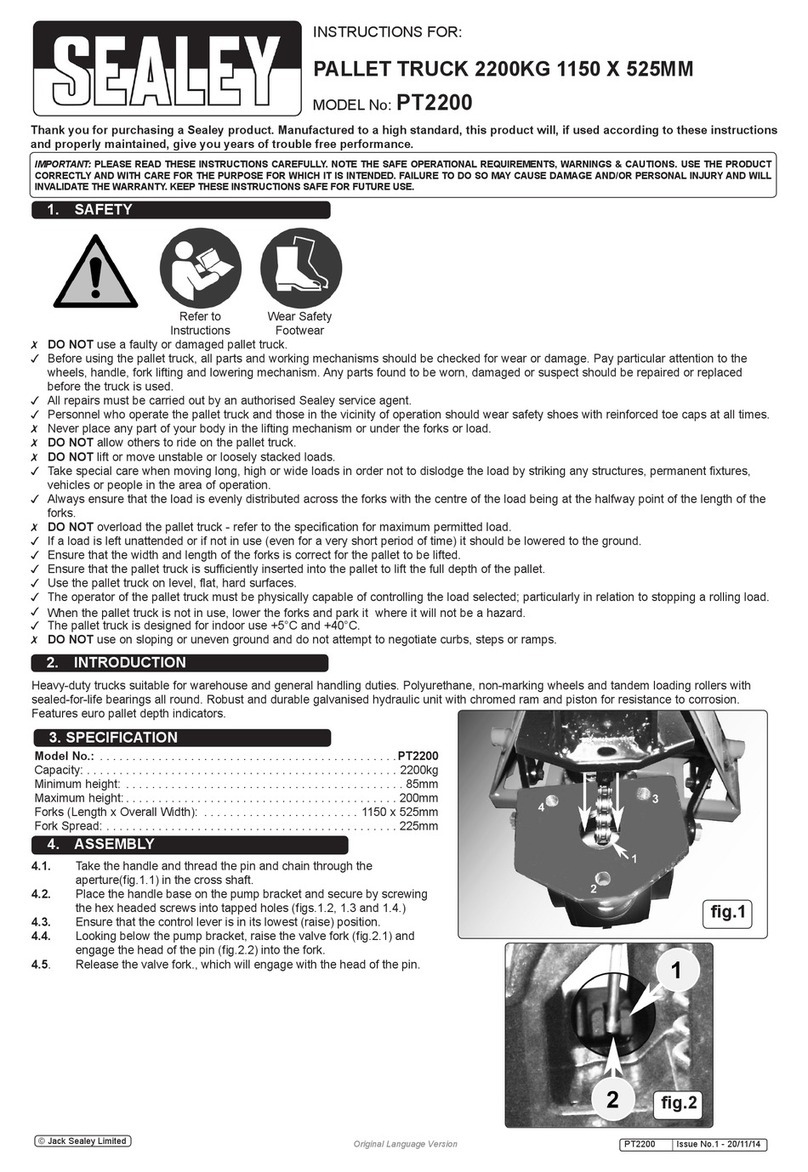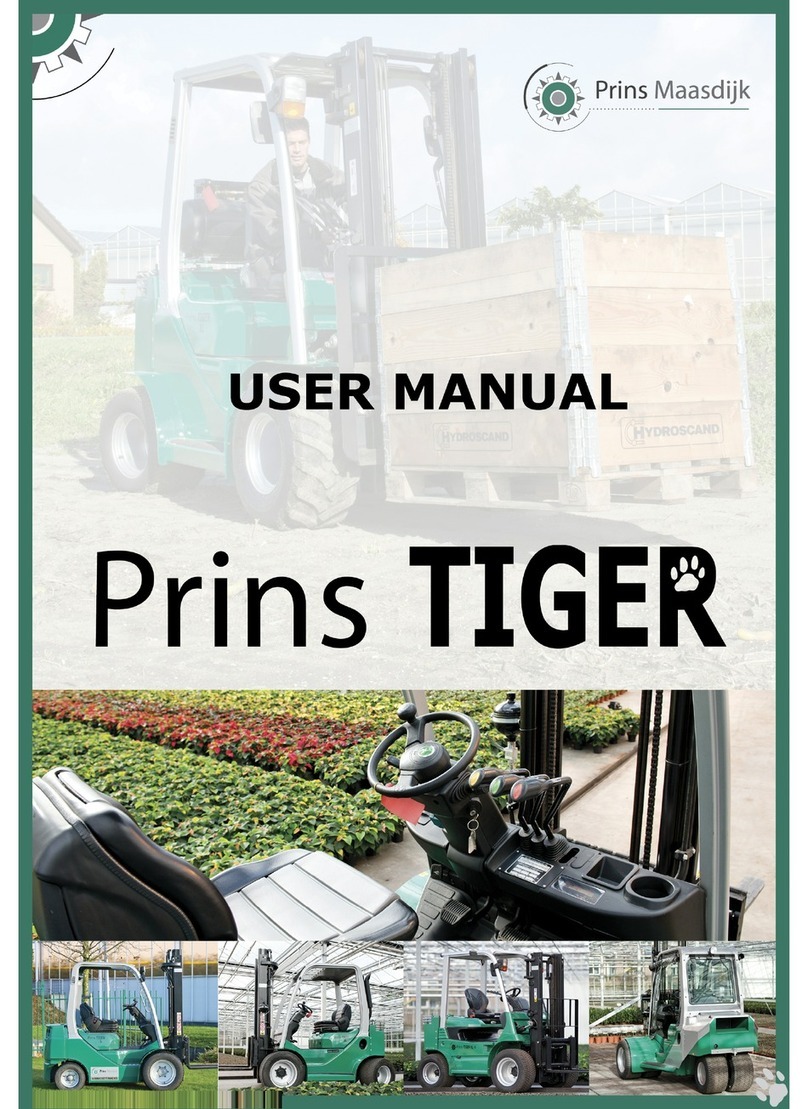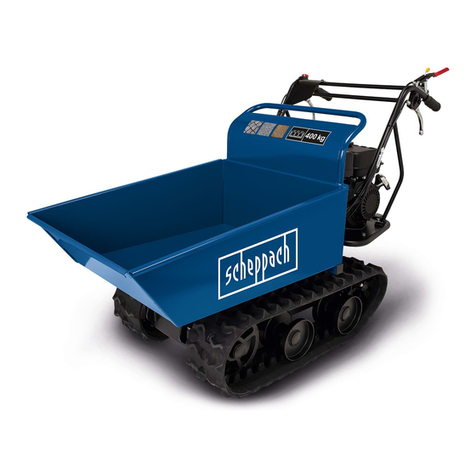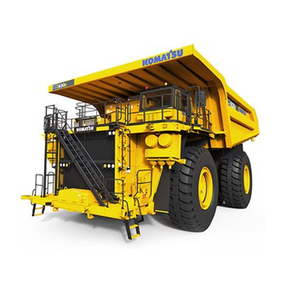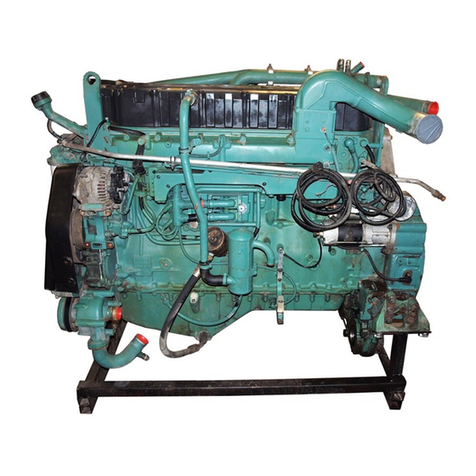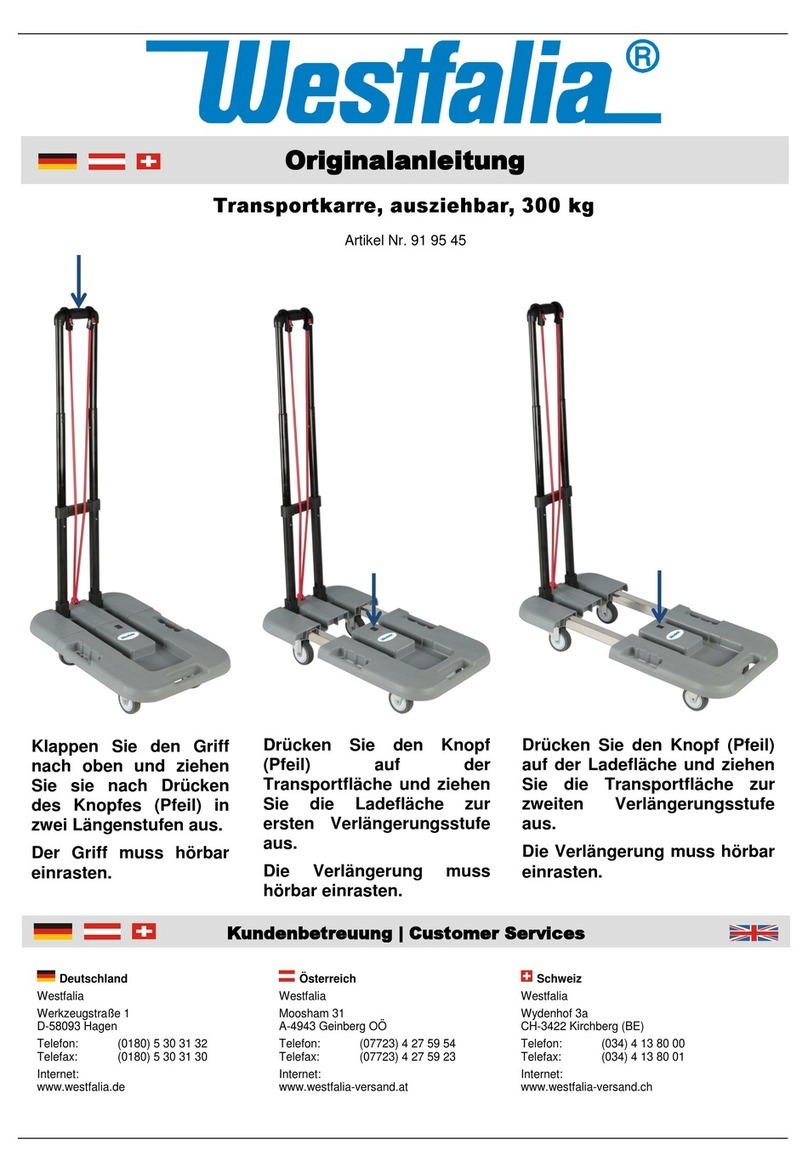EKKO EP15JLi User manual

Service manual
Electric Pallet Truck
EP15JLI/EP18JLI/EP20JLI
Warning
You must understand the operation instructions in this manual
before using it.
Note:
Please check the last page of this document and nameplate for
all current product type identification.
Keep it for future use

Directory
1. Regular maintenance............................................................................................................................ 1
1.1. Maintenance list............................................................................................................................. 1
1.2. Lubrication points .......................................................................................................................... 3
1.3. Check and refill hydraulic oil.......................................................................................................... 4
1.4. Check the electrical fuse ............................................................................................................... 5
2. fault analysis ......................................................................................................................................... 6
2.1. Common fault analysis.................................................................................................................. 6
2.2. Display of fault code...................................................................................................................... 7
3. Circuit/circuit diagram........................................................................................................................... 9
3.1. Electrical schematic diagram......................................................................................................... 9
3.2. hydraulic principle diagram...........................................................................................................11
4. Dis assembly of main parts................................................................................................................. 12
a、Electromagnetic brake adjustment ................................................................................................. 12
b、Drive the dis assembly diagram...................................................................................................... 13
c、hand assembly Operating handle assembly................................................................................... 14
5. CURTIS Handheld unit ....................................................................................................................... 15

1
1. Regular maintenance
Only qualified and trained personnel should perform maintenance work on this vehicle.
Before maintenance, remove the cargo from the fork and lower the fork to the lowest
position.
If you need to lift the vehicle, use the specified lashing or jacking equipment. Before
operation, place safety devices (such as designated jacks, wedges or wood blocks)
under the vehicle to prevent accidental drop, movement or sliding.
Use the original parts approved and released by your dealer.
Please consider that hydraulic fluid leakage may lead to machine failure and accidents.
Pressure valve adjustment is only allowed by trained service technician.
If you need to replace wheels, casters must be round and free of abnormal wear.
Check the items on the maintenance list。
1.1. Maintenance list
间隔(月)
1
3
6 12
hydraulic system
1.1 Check the function of hydraulic system •
1.2 Check hoses, piping and joints for tightness, sealing and damage
•
1.3 Inspect cylinder block and piston for damage, sealing and fixation
•
1.4
Visually inspect the door stand roller and inspect the roller
surface for wear
•
1.5 Inspect forks and loading parts for wear and loss •
1.6 Check load chain Settings and re-tensioning if necessary •
1.7 Check oil level in fuel tank •
1.8 Replacement hydraulic fluid •
mechanical system
2.1 Check the fork for deformation and breakage •
2.2 Check chassis for deformation and cracking •
2.3 Check that all screws are in place •
2.4 Check gear box for noise and leakage •
2.5 Check wheel for deformation and damage •
2.6 Lubricated steering bearing •
2.7 Check and lubricate the pivot points •
2.8 Lubricating grease nozzle •
Electric System
3.1 Check whether electrical wiring is damaged •
3.2 Checking Electrical Connections •
3.3 Check emergency switch function •
3.4 Check electric drive system for noise and damage •
3.5 Detection meter •
3.6 Check that the correct fuse is used •

2
3.7 Check alarm system and safety devices •
3.8 Check the current contactor •
3.9 Check frame for leakage (insulation test) •
3.10
Check the function and wear of the drive controller •
3.11
Check the electrical system driving the motor •
traveling system
4.1 Check the gearbox for abnormal sound •
4.2 Check the driving mechanism and grease it •
4.3 Inspect driving and steering wheels for wear and damage •
4.4 Check wheel bearing and fastening condition •
4.5 Check the air gap of the electromagnetic brake •
4.6
Check the lifting, forward and backward tilt and left and right
movement of the door frame
•
4.7 Check and adjust braking effect •
energy supply
5.1 Check the voltage of the battery •
5.2 Check that battery cables are securely connected and grease the
electrodes if necessary
•
5.3 Check whether the battery cover is damaged •
5.4 Check the main cable for damage •
5.5 Check the startup protection program during charging •
monolithic component
6.1 Check all labels for clarity and completeness •
6.2 Check the frame for damage •
6.3 Check the fixing condition of lifting door frame •
6.4 Run a test run •

1.2. Lubrication points
Lubricate marked points according to maintenance list. Required grease specification: DIN 51825
standard grease.
Figure 1:Lubrication points
Drive the oil injection port

4
1.3. Check and refill hydraulic oil
Recommended hydraulic oil model according to temperature:
Ambient
temperature
–5℃~25℃>25℃
mark HVLP 32,
DIN 51524
HLP 46,
DIN 51524
Viscosity 28.8-35.2 41.4 - 47
Oil 1L
Waste materials such as waste oil, waste batteries or other materials must be treated
and recycled in accordance with national regulations, and returned to the recycling
company for recycling if necessary.
The oil level should not be lower than the minimum amount required to start the
vehicle.
Fill up to refueling point if necessary。
Bogie bearing

5
1.4. Check the electrical fuse
10A Fuse
List 2:Fuse specification
specification
Fuse 1 10A
Fuse 01 200A
200A Fuse

6
2. Fault analysis
If the vehicle continues to malfunction, follow the instructions in the manual.
2.1. Common fault analysis
Fault Cause Processing method
Vehicles
cannot move
The battery connector is
not connected
Check the battery connector and
connect it if necessary
The electric lock switch
is in "OFF" position
The electric lock switch is
placed in the "0" position
The emergency stop switch
is not on
Turn on the emergency stop
switch
Battery running out
Check the charging status of
the battery and recharge it if
necessary
The forklift is charging Interrupt charging process
Fuse damage Check fuse
Cargo cannot
be lifted
The vehicle is not running
Follow the procedure listed in
the "Vehicle cannot Move" fault
There's too little
hydraulic fluid
Check hydraulic oil
Fuse damage Check fuse
Load overweight Note rated load
The lift micro
switch is
in bad contact or damaged
Check fuse
Goods cannot
be lowered
Dirty oil clogs the
control valve
Check the hydraulic oil and
clean the control valve and
replace the hydraulic oil if
necessary
The descent solenoid
valve is not open or
damaged
Check the drop solenoid or
replace it
can't stop
when go up
The lifting micro switch
is damaged
Cut off the power supply and
replace the lifting micro
switch
Moving in one
direction
Contact between micro
switch and connecting
cable is not good
Check the micro switch and
connecting cable in the control
handle
Traffic moves
slowly
The battery power is low
or the corresponding
cable is in poor contact
Check the battery indicator and
corresponding cables

7
The vehicle
started
suddenly
Controller damage Replacing a Controller
Control forward and
backward handle is not
reset
To restore or replace
2.2. Display of fault code
Table 4:1212P fault codes
Programmer display
Code The fault phenomenon fault diagnosis
BATTERY DISCONNECT
FAULT
4.5
Battery don't answer 1) The battery is not connected
2) Poor contact of battery end
BRAKE OFF FAULT
3.4
Brake closing fault 1) Electromagnetic brake coil short
circuit
2) Electromagnetic brake drive open
circuit
BRAKE ON FAULT
3.2
Brake opening failure 1) Electromagnetic brake coil open
2) Electromagnetic brake drive short
circuit
CURRENTSENSE FAULT
4.1
Current detection fault 1) Short circuit of motor or motor
wiring
2) The controller is faulty
EEPROM CHECKSUM
FAULT
4.3
EEPROM failure 1) EEPROM is faulty or invalid
HARDWARE FAILSAFE
4.2
Motor voltage is out of
range
1) Motor voltage cannot match
accelerator input
2) Short circuit of motor or motor
matching ring
3) The controller is faulty
HPD FAULT
3.5
HPD Fault
1) Accelerator, key switch, promotion
or prohibition
Input several actions out of order
2) Wrong adjustment of accelerator
MAIN FAULT
2.3
The main contactor is
faulty
1) Main contactor adhesion or open
2) Main contactor coil drive error
MAIN OFF FAULT
2.1
Main contactor coil
drive 'off' failure
1) Wrong opening of main contactor coil
MAIN ON FAULT
2.4
Main contactor coil
drive 'on' failure
1) The main contactor coil is closed
incorrectly
OVERVOLTAGE FAULT
1.5
Battery voltage is too
high
1) Battery voltage >31V
2) The charger is still connected when
the vehicle is running
3) Poor battery contact

8
PRECHARGE FAULT
3.3
Pre charge failure 1) The controller is faulty
2) Low battery voltage
SPEED POT FAULT
1.3
The speed limiting
potentiometer is faulty
1) Open or short circuit connection of
speed limiting potentiometer
2) Open speed limiting potentiometer
THERMAL FAULT
1.1
Over/under temperature
cut-off
1) Temperature >80℃or <-10℃
2) Vehicle overload
3) Operate in extremely harsh
environment
4) The electromagnetic brake is not
released normally
THROTTLE FAULT
1.2
Potentiometer slip end
or low
1) Accelerator input is open or short
2) Accelerator potentiometer failure
3) Wrong selection of accelerator type
UNDERVOLTAGE FAULT
1.4
The terminal voltage is
out of range
1) Battery voltage <17V
2) The battery or controller is not
connected properly
Methods for troubleshooting common faults
Code 4.5 The battery is not connected
1、Check whether the fastening of cable terminals of the car body is loose, as shown below:
Check whether the cable connection (including other secured
parts) is loose

9
3. Circuit/circuit diagram
3.1.Electrical schematic diagram
(24V)

10
(48V)

11
3.2. hydraulic principle diagram
Hydraulic oil inspection
appearance smell situation The results of
Clear and non-discoloration
good
good
You can use
Color transparent good Mix with other oils
Check viscosity, if
qualified can continue to
use

12
The color changes like milk good
Mixed with air and
water
Separate moisture or
replace hydraulic oil
The color turns dark brown bad oxidation
Replacement of hydraulic
fluid
The color is clear but there
are small black spots
good
Mix it with other
particles
Use after filtering
4. Disassembly of main parts
A、Electromagnetic brake adjustment
adjusting
Electromagnetic brake clearance is about 25-35
wire, about one hundred thickness. Need to be
adjusted carefully repeatedly, ensure that three
adjustment surface clearance
is consistent,
electricity will give out a crisp sound.
Note: electromagnetic brake
can't pull properly when it is
powered on in free state, it
needs external force or
installation to pull

13
B、Drive the disassembly diagram
electromagnetic
brake
drive motor
Driving
wheel
gear case

14
C、hand assembly Operating handle assembly
Accelerator knob
Belly switch
horn button
Motion plus
Tortoise speed switch

15
5. CURTIS Handheld unit
Precautions for operation:
The attention function of the hand-held unit is to facilitate vehicle inspection and maintenance. It is not
allowed to adjust the controller parameters without the approval of the vehicle manufacturer, so as to
avoid vehicle and personal safety accidents.
The hand-held unit will automatically save the modification parameters, just need to close the key switch,
restart.
The CURTIS handheld unit can be connected in the event of a controller power or power failure
Vehicle fault reading process:
1、After connecting the handheld unit with the controller, open the key switch
2、From the menu list of CURTIS handheld units, find: Faults...
3、When the vehicle is running and the hand-held cursor flashes, there will be English fault content,
which can be interpreted by referring to the fault code table
Vehicle signal detection:
1、After connecting the handheld unit with the controller, open the key switch
2、According to the menu list of CURTIS handheld unit, find: Monitor......
3、According to requirements, open the corresponding sub-item of the detection menu, run the vehicle,
and observe the change of the hand-held value.
CURTIS Handheld Unit Menu contents:
The Curtis 1313 handheld programmer is used to configure the Curtis electric control system.Through
this programmer, you can adjust and save the set parameters, real-time monitoring of controller data and
fault diagnosis
Warning: The control system can affect the vehicle's
acceleration rate, deceleration rate, hydraulic
system and braking. A dangerous situation can
occur if the vehicle control system is not
programmed correctly or exceeds safety. Only the
vehicle manufacturer or an authorized service agent
can program the control system

16
The programmer has two interfaces, one is used to communicate with the electric control, the other is
used to communicate with the PC, the programmer has a battery box and a memory card slot
The programmer is powered on
The connection line of the handheld programmer can be connected to the controller by inserting the
programming port of the controller. After connecting the controller, the handheld programmer will be
powered on automatically and the control information will be displayed on the programmer

17
The menu structure
The main menu consists of nine sub-menus, and each
sub-menu is displayed with a specific icon. Each item in
the sub-menu is arranged by hierarchy.
Some menus contain only one item of information, but
most menus contain more than one item of information,
and open each item folder to access the next level of
submenus. Expand the table through the grid option, enter
a group of execution commands through the dialog box
option, and return to the upper menu regardless of the
interface by pressing the left direction button.
The names of all nine submenus are shown in bold on the
main menu and below the icon.When entering the stepped
menu, the name of the submenu or the path you are in is
displayed at the top of the screen.
The function keys
Since the function of the three
keys is determined by the
specified content, the three
keys are blank. At any given
time, the function of the
button is displayed on the
LCD screen above.
Direction arrow key
The displayed information can
be selected up, down, or left
by four directional buttons.
+ / - buttons
You can add and subtract
parameters by using these
two keys. In addition, "+" can
mean "Yes" and "-" can mean
"No”. In some cases, it can
also be used as a scrolling
option.
Power key
When the programmer inserts
a controller that has been
powered on, the programmer
does not have to press the
power button to use it. The
programmer will start up
automatically. When you hold
it down for a few seconds, the
programmer will prompt you
whether to turn it off. You can
decide whether to turn it off by
selecting the "Yes" and "No"
represented by the function
key. After clo
sing the
programmer, press for a few
seconds and the programmer
will restart. Collection keys
There are two ways to enter
the Favorites menu. You can
enter Favorites from the main
menu or press this key

18
Nine menu
Fault Diagnosis menu
On the main menu, Select Diagnostics and press Select to access the Fault diagnosis menu. The Fault
diagnosis menu contains Present Errors current faults and Fault History historical faults
Note: Sometimes a fault caused by a temporary event captured in the circuit is not a system fault. You
can determine whether the fault exists by restarting the system and observing whether the fault
disappears automatically.
The historical faults folder lists all faults encountered after the last historical fault is cleared. By clearing
the fault content in the entire folder, you can record the historical faults again.
Clear All is used to Clear historical
fault folders. A
function key is
highlighted only when there are
historical failures in the historical
failures folder and grayed out when
there are no historical failures.
Other manuals for EP15JLi
1
This manual suits for next models
2
Table of contents
Other EKKO Truck manuals


